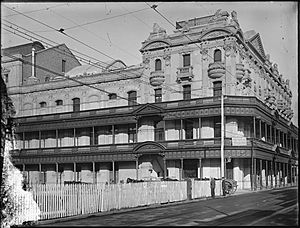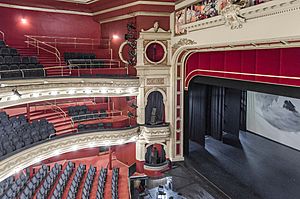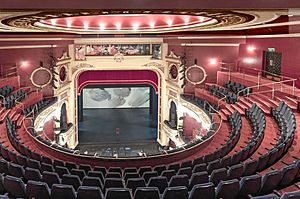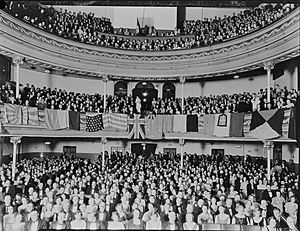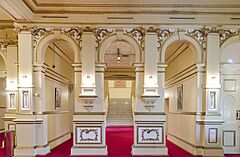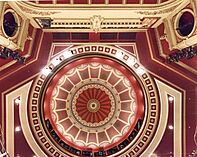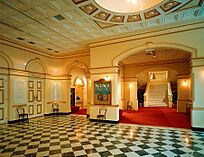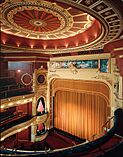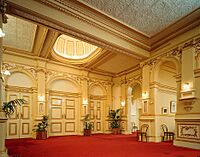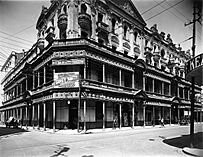His Majesty's Theatre, Perth facts for kids
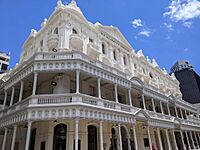
His Majesty's Theatre in 2022
|
|
| Address | 825 Hay Street Perth Australia |
|---|---|
| Coordinates | Lua error in Module:Coordinates at line 614: attempt to index field 'wikibase' (a nil value). |
| Owner | Government of Western Australia |
| Capacity | 1,263 |
| Construction | |
| Opened | 24 December 1904 |
| Architect | William G. Wolfe |
| Type | State Registered Place |
| Designated | 16 December 1994 |
| Reference no. | 2006 |
His Majesty's Theatre is a beautiful old theatre in Perth, Western Australia. It was built between 1902 and 1904, a time when Perth was growing very fast. You can find it in the middle of Perth, at the corner of Hay Street and King Street.
When it first opened, it was the biggest theatre in Australia. It could seat over 2,500 people! It was also one of the first buildings in Perth made with reinforced concrete, which is concrete strengthened with steel bars.
Over the years, the theatre has hosted many amazing shows. These include big musicals, ballet, opera, and plays by William Shakespeare. It has been updated several times. A major renovation happened in the late 1970s when the government bought it. They made it look beautiful again and added modern features.
Since then, His Majesty's Theatre has been the home for the West Australian Ballet and West Australian Opera companies. Both groups perform there regularly. The theatre is very important to Western Australia's culture. It is listed on the Western Australian Register of Heritage Places and is known as a "State Heritage Icon." It is also thought to be the only working theatre from the Edwardian period left in Australia.
Contents
Building the Theatre
At the start of the 1900s, Perth was booming because of the gold rush in Western Australia. This wealth led to the construction of many grand buildings. A local politician named Thomas Molloy decided to build a new theatre and hotel complex. He wanted it to be named His Majesty's Theatre and Hotel to honor King Edward VII.
The architect for this project was William G. Wolf, who had designed other buildings for Molloy. The chosen spot was a busy corner on King Street and Hay Street. In June 1902, Molloy got permission to build the theatre, promising it would be finished within a year.
A builder named Friederich Liebe won the contract to construct the complex. He had worked on famous buildings like the Budapest Opera House. The building cost about £A43,000, which was a huge amount of money back then. Construction began in November 1902.
Building Challenges and Solutions
During construction, people worried about the building's foundations. The site had a high water table and an underground stream. Liebe, the builder, worked with the architect to create a new plan. This plan included drains to move the water away.
Liebe went ahead with these changes, thinking Molloy had agreed. The building was finished on time. However, a disagreement arose over an extra £A17,000 for the foundation work. Molloy refused to pay more than the original price. Liebe took him to court, and after a long legal battle, Liebe eventually won.
After some final checks for fire safety, the theatre officially opened on Christmas Eve in 1904. Sylvia Forrest, whose uncle was former premier John Forrest, opened the theatre. The first show was "Pollard's Adult Opera Company" performing The Forty Thieves.
Theatre Design and Features
When it opened, His Majesty's Theatre was the largest theatre in Australia. It also had the biggest stage and the tallest fly tower (the space above the stage where scenery is stored). It was one of the first buildings in Perth to use reinforced concrete.
The building is four stories tall and its design was inspired by theatres in England and Europe. It is a great example of the Edwardian Baroque architecture style.
The theatre complex also included a 65-room hotel, separated from the theatre by iron doors. The hotel had billiard rooms, parlors, and six bars for theatregoers. The building used a lot of iron, steel, and millions of local bricks. It also featured imported marble and special tiles. An electric lift went to the roof, where an observation platform offered amazing views of the city.
The main performance area, called the auditorium, had a proscenium arch and a sloped stage. The auditorium was designed in a horseshoe shape, common in Edwardian theatres, to bring the audience closer to the performers. It originally held 2,584 people across three levels: the stalls, the dress circle, and an upper gallery, plus private boxes.
The theatre had some cool features to keep people comfortable. There were four small waterfalls on either side of the stage. These, along with electric fans and a retractable dome in the ceiling, were meant to cool the audience. The dome could slide open, and it was decorated to look like an umbrella. The waterfalls were removed early in the theatre's history.
The outside of the theatre originally had two levels of balconies. These were removed in 1947-48 because they were thought to be a traffic hazard. This change made the top of the building look a bit different from the lower parts, which used to be hidden by the balconies.
Theatre's History and Updates
For its first 70 years, His Majesty's Theatre hosted many different events. These included Shakespearean plays, opera, political meetings, boxing matches, and movie screenings. It was especially known for its excellent sound quality. During World War II, it mostly showed movies because it was hard for touring groups to travel.
The theatre was updated in 1912 and again in 1948. The 1948 renovation included new electrical systems backstage and might have been when the outside balconies were removed. In 1952, the Edgley family leased the theatre and used it for "Russian spectaculars." They later bought the theatre in 1969.
However, by the mid-1970s, newer venues like the Perth Entertainment Centre and Perth Concert Hall became more popular. His Majesty's Theatre started to fall into disrepair.
Major Renovation in the 1970s
After a public campaign to save it, the Government of Western Australia bought the theatre in 1977. The government promised to restore it, and a $10.5 million renovation project began. The last show before closing for renovations was Iolanthe. The work took three years and was managed by architects Hill and Parkinson.
The renovation brought big changes to the theatre and hotel. Architects decided to restore the theatre's original design rather than completely change it. Inside the auditorium, the floor of the stalls had to be completely replaced. The stage was made flat, and the proscenium arch was widened and redecorated. The ceiling was also replaced with a new plaster copy of the original. The sliding dome in the roof was permanently sealed and redecorated to look like it did in 1904. The orchestra pit was made bigger, and new lighting and stage equipment were installed.
The hotel part of the building was separated from the theatre. It was renovated to provide offices for the West Australian Opera and West Australian Ballet, as well as backstage areas for visiting performers. A new building was added behind the theatre for dressing rooms, rehearsal spaces, and a new air conditioning system.
The theatre's grand marble staircase was moved to create a larger entrance area. The old Sportsman's Bar became the new box office. Soundproofing was also added to reduce noise from the street.
There was some discussion about who should manage the theatre after the renovation. Eventually, the Perth Theatre Trust was created to run it. His Majesty's Theatre reopened on May 28, 1980, with a new seating capacity of 1,250. Its importance was recognized when it was added to the Register of the National Estate in 1978 and the Western Australian Register of Heritage Places in 1994.
The Theatre in the 21st Century
In December 2004, the theatre was named a State Heritage Icon. Since February 2001, it has also been home to a Museum of Performing Arts.
In 2004, the theatre celebrated its 100th birthday with special events. In 2006, it became "twinned" with the only other theatre in the world with the same name, His Majesty's Theatre in Aberdeen, Scotland.
Today, His Majesty's Theatre is still managed by the Perth Theatre Trust. It is believed to be the only working Edwardian theatre left in Australia.
In 2008, a company called Savcor checked the theatre's exterior. They found some damage to the outside walls. In 2010, a project began to fix these issues. Damaged decorations were carefully replaced to look exactly like the originals. Many of the balconies had to be completely rebuilt. Special techniques were used to make sure the new balconies were strong and looked just like the old ones.
In December 2021, another big renovation started. This project aimed to bring back the external balcony structures that were removed in the 1940s. The Perth Theatre Trust wanted to restore the theatre's original look and improve the entrance areas. This would make the theatre more welcoming and functional for future generations. The old canopy was removed and replaced with two levels of new balconies. These new balconies were designed to be even more useful than the originals. The work was finished at the end of 2022, making the theatre look grand once again.
Famous Performers and Shows
His Majesty's Theatre is not only home to the West Australian Opera and West Australian Ballet, but it has also welcomed many famous performers over the years. Here are some of the notable artists who have graced its stage:
- Edouard Borovansky – a Czech-Australian ballet dancer who visited five times.
- Claudette Colbert – a French-born American actress.
- Peter Cook – an English comedian who toured with Dudley Moore.
- Margot Fonteyn – a famous English ballerina.
- Amelita Galli-Curci – an Italian opera singer known for her high notes.
- John Gielgud – an English actor and singer.
- Percy Grainger – an Australian-born pianist and composer.
- Rex Harrison – an English actor.
- Robert Helpmann – an Australian actor and dancer, who starred with Katharine Hepburn in Shakespeare plays.
- Katharine Hepburn – an American actress, who starred with Robert Helpmann in Shakespeare plays.
- Barry Humphries – an Australian comedian, famous for playing Dame Edna Everage.
- James Earl Jones – an American actor, who starred in "Driving Miss Daisy" in 2013.
- Angela Lansbury – a British-American actor, who starred in "Driving Miss Daisy" in 2013.
- Harry Lauder – a Scottish entertainer who performed in 1923.
- Vivien Leigh – an English actress, who starred in Twelfth Night in 1962.
- Ian McKellen – an English actor, who starred in "Waiting for Godot" in 2010.
- Nellie Melba – a famous Australian opera singer.
- Gladys Moncrieff – an Australian singer and musical theatre actress.
- Dudley Moore – an English actor and comedian, who toured with Peter Cook.
- Anna Pavlova – a legendary Russian ballerina.
- Geoffrey Rush – an Australian actor.
- Maggie Smith – an English actress.
- Sybil Thorndike – an English actress.
- Emlyn Williams – a Welsh actor, who played Charles Dickens in 1958.
Gallery
See also
- The Playhouse Theatre (Perth)
- Regal Theatre
- Perth Theatre Trust


